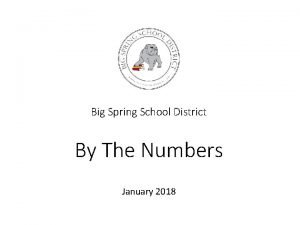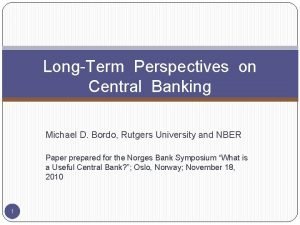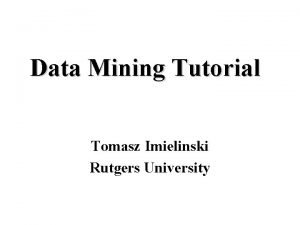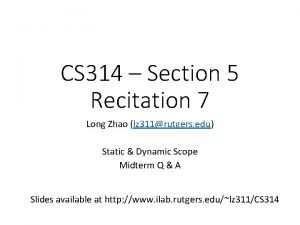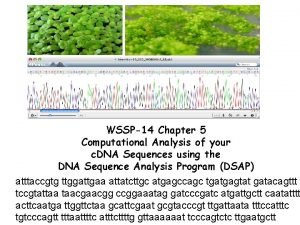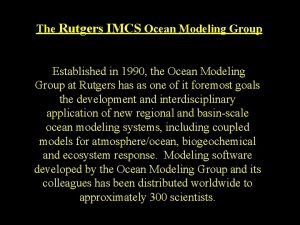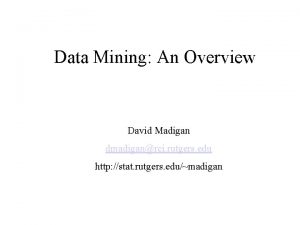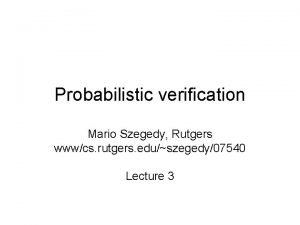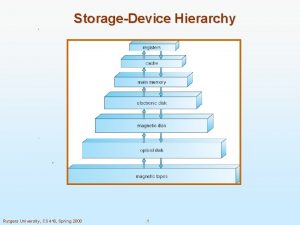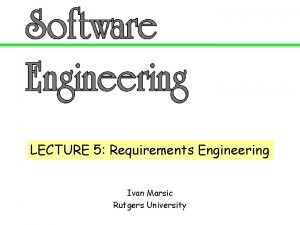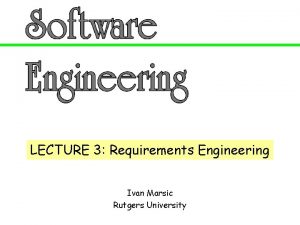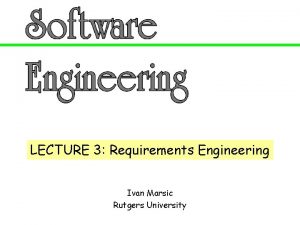Rutgers University School of Engineering Spring 2015 14



![Example 1: User-defined functions function handle M-file: fmaxbnd. m function [xmax, fmax] = fmaxbnd(f, Example 1: User-defined functions function handle M-file: fmaxbnd. m function [xmax, fmax] = fmaxbnd(f,](https://slidetodoc.com/presentation_image_h2/127b5a15b947a6d5cb07223b41193c35/image-4.jpg)
![[xmax, fmax] = fmaxbnd(@xsin, 0, 3); [xmax, fmax] = fmaxbnd(f, 0, 3); x = [xmax, fmax] = fmaxbnd(@xsin, 0, 3); [xmax, fmax] = fmaxbnd(f, 0, 3); x =](https://slidetodoc.com/presentation_image_h2/127b5a15b947a6d5cb07223b41193c35/image-5.jpg)









![x = [10, -20, 30, 5, 25]; S = 0; for k=1: length(x) S x = [10, -20, 30, 5, 25]; S = 0; for k=1: length(x) S](https://slidetodoc.com/presentation_image_h2/127b5a15b947a6d5cb07223b41193c35/image-15.jpg)

![x = [10, -20, 30, 5, 25]; y(1) = x(1); for k=2: length(x) y(k) x = [10, -20, 30, 5, 25]; y(1) = x(1); for k=2: length(x) y(k)](https://slidetodoc.com/presentation_image_h2/127b5a15b947a6d5cb07223b41193c35/image-17.jpg)
![x = [10, -20, 30, 5, 25]; y(1) = x(1); k = 2; while x = [10, -20, 30, 5, 25]; y(1) = x(1); k = 2; while](https://slidetodoc.com/presentation_image_h2/127b5a15b947a6d5cb07223b41193c35/image-18.jpg)





















- Slides: 39

Rutgers University School of Engineering Spring 2015 14: 440: 127 - Introduction to Computers for Engineers Sophocles J. Orfanidis ECE Department orfanidi@ece. rutgers. edu Week 9 - Review Examples for Weeks 5 -8

Weekly Topics Week 1 - Basics – variables, arrays, matrices, plotting (ch. 2 & 3) Week 2 - Basics – operators, functions, strings, cells (ch. 2, 3, 11) Week 3 - Matrices (ch. 4) Week 4 - Plotting – 2 D and 3 D plots (ch. 5) Week 5 - User-defined functions (ch. 6) Week 6 - Input-output formatting – fprintf, fscanf (ch. 7) – Exam 1 Week 7 - Relational & logical operators, if, switch statements (ch. 8) Week 8 - For-loops, while-loops (ch. 9) Week 9 - Review for weeks 5 -8 Week 10 - Matrix algebra – solving linear equations (ch. 10) – Exam 2 Week 11 - Numerical methods I (ch. 13) Week 12 - Numerical methods II (ch. 13) Week 13 - Strings, structures, cell arrays, symbolic math (ch. 11, 12) Week 14 – Exam 3 References: H. Moore, MATLAB for Engineers, 4/e, Prentice Hall, 2014 G. Recktenwald, Numerical Methods with MATLAB, Prentice Hall, 2000 A. Gilat, MATLAB, An Introduction with Applications, 4/e, Wiley, 2011

Review Examples 1. User-defined functions 2. Pitfalls in piece-wise function definitions 3. Finite for-loop & while-loop examples 4. Terminating divergent while-loops 5. Summing infinite series with prescribed accuracy 6. Vectorized forms of fprintf / fscanf
![Example 1 Userdefined functions function handle Mfile fmaxbnd m function xmax fmax fmaxbndf Example 1: User-defined functions function handle M-file: fmaxbnd. m function [xmax, fmax] = fmaxbnd(f,](https://slidetodoc.com/presentation_image_h2/127b5a15b947a6d5cb07223b41193c35/image-4.jpg)
Example 1: User-defined functions function handle M-file: fmaxbnd. m function [xmax, fmax] = fmaxbnd(f, a, b) [xmax, fmax] = fminbnd(@(x) -f(x), a, b); fmax = -fmax; M-file: xsin. m function y = xsin(x) y = x. *sin(x); anonymous definition f = @(x) x. *sin(x);
![xmax fmax fmaxbndxsin 0 3 xmax fmax fmaxbndf 0 3 x [xmax, fmax] = fmaxbnd(@xsin, 0, 3); [xmax, fmax] = fmaxbnd(f, 0, 3); x =](https://slidetodoc.com/presentation_image_h2/127b5a15b947a6d5cb07223b41193c35/image-5.jpg)
[xmax, fmax] = fmaxbnd(@xsin, 0, 3); [xmax, fmax] = fmaxbnd(f, 0, 3); x = linspace(0, 3, 301); y = xsin(x); plot(x, y, 'b', xmax, fmax, 'ro'); [xmax, fmax] ans = 2. 0288 1. 8197

Example 2: Pitfalls in piece-wise function definitions method 1 – vectorized – using relational operators method 2 – vectorized – using the function find method 3 – not vectorized – used with a for-loop implemented in the M-files: f 1. m, f 2. m, f 3. m

method 1 – vectorized – using relational operators M-file: f 1. m function y = f 1(x) y = exp(x+1). *(x<-1) +. . . abs(x). *(abs(x)<=1) +. . . exp(-x+1). *(x>1); anonymous definition is best f 1 = @(x) exp(x+1). *(x<-1) +. . . abs(x). *(abs(x)<=1) +. . . exp(-x+1). *(x>1); shape of x is automatically preserved

method 2 – vectorized – using the function find M-file: f 2. m function y = f 2(x) y = zeros(size(x)); i = find(x<-1); y(i) = exp(x(i)+1); i = find(x>1); y(i) = exp(-x(i)+1); i = find(abs(x)<=1); y(i) = abs(x(i)); % preserve shape of x

method 2 – vectorized – equivalent to using find M-file: f 2 b. m – does not use find but it’s hard to read function y = f 2 b(x) y = zeros(size(x)); % preserve shape of x y(x<-1) = exp(x(x<-1)+1); y(x>1) = exp(-x(x>1)+1); y(abs(x)<=1) = abs(x(abs(x)<=1));

method 3 – not vectorized – must be used with a for-loop scalar x M-file: f 3. m function y = f 3(x) if x<-1 y = exp(x+1); elseif x>1 y = exp(-x+1); else y = abs(x); end Pitfall: although it most clearly displays the logic of the function definition, it produces the wrong result if a vector x is used as input see explanation below

x = linspace(-2, 2, 201); figure; plot(x, f 1(x), 'b'); yaxis(0, 2, 0: 2); % f 2(x) is the same figure; plot(x, f 3(x), 'r'); yaxis(0, 2, 0: 2); % f 3(x), vector x wrong figure!

>> x = -2: 0. 5: 2 x = -2 -1. 5 -1 >> x<-1 ans = 1 -0. 5 0 0. 5 1 1. 5 1 0 0 0 0 1 1 2 >> x>1 ans = 0 explanation of pitfall: if x<-1 test fails, then elseif x>1 test also fails, hence, else is executed, so result is |x| for all x. if x<-1 y = exp(x+1); elseif x>1 y = exp(-x+1); else y = abs(x); end

% correct usage of f 3(x) for n=1: length(x) y(n) = f 3(x(n)); end figure; plot(x, y, 'r'); yaxis(0, 2, 0: 2);

Example 3: Finite for-loop & while-loop examples Imitate the function S = sum(x)
![x 10 20 30 5 25 S 0 for k1 lengthx S x = [10, -20, 30, 5, 25]; S = 0; for k=1: length(x) S](https://slidetodoc.com/presentation_image_h2/127b5a15b947a6d5cb07223b41193c35/image-15.jpg)
x = [10, -20, 30, 5, 25]; S = 0; for k=1: length(x) S = S + x(k); end for-loop S = 0; k=1; while k<=length(x) S = S + x(k); k = k+1; end conventional while-loop S = 0; k=1; while 1 if k>length(x), break; end S = S + x(k); k = k+1; end % sum(x) = 100 forever while-loop

Imitate the function y = cumsum(x)
![x 10 20 30 5 25 y1 x1 for k2 lengthx yk x = [10, -20, 30, 5, 25]; y(1) = x(1); for k=2: length(x) y(k)](https://slidetodoc.com/presentation_image_h2/127b5a15b947a6d5cb07223b41193c35/image-17.jpg)
x = [10, -20, 30, 5, 25]; y(1) = x(1); for k=2: length(x) y(k) = y(k-1) + x(k); end for-loop >> y y = 10 -10 20 70 75 100 >> y = cumsum(x) y = 10 -10 20
![x 10 20 30 5 25 y1 x1 k 2 while x = [10, -20, 30, 5, 25]; y(1) = x(1); k = 2; while](https://slidetodoc.com/presentation_image_h2/127b5a15b947a6d5cb07223b41193c35/image-18.jpg)
x = [10, -20, 30, 5, 25]; y(1) = x(1); k = 2; while k <= length(x) y(k) = y(k-1) + x(k); k = k+1; end conventional while-loop, it computes the values, y(2), k=3; y(3), k=4; etc. y(1) = x(1); k = 2; while 1 if k > length(x), break; end y(k) = y(k-1) + x(k); k = k+1; end forever while-loop

Imitating the function find using a for-loop % % consider the grades of 10 students in the vector g, find number of B+ grades in g, i. e. , in range 85 <= g < 90 find their locations within g, i. e. , their student number find their actual numerical values g = [67, 85, 95, 87, 88, 75, 89, 70, 76, 86] G = grade(g) % numerical grades % letter grades % vectorized method: i = find(g >= 85 & g < 90) count = length(i) Bp = g(i) % i = % 2 4 % count = % 5 % Bp = % 85 87 5 7 10 88 89 86 % indices of B+'s % number of B+'s % actual numerical values

Imitating the function find using a for-loop % for-loop method: count = 0; i = []; Bp = []; % initialize count % initialize indices % initialize grades for k = 1: length(g) if g(k) >= 85 & g(k) < 90 i = [i, k]; count = count + 1; Bp = [Bp, g(k)]; end % i = % 2 4 % count = % 5 % Bp = % 85 87 5 7 10 88 89 86 % % check grade range append index update count append numerical value

double for-loops N = 4; M = 5; arbitrary example: for i=1: N for j=1: M A(i, j) = 2^i+2^j; end >> A A = 4 6 10 18 6 8 12 20 10 12 16 24 18 20 24 32 34 36 40 48

% vectorized row-wise % vectorized column-wise N=4; M=5; j=1: M; N=4; M=5; i=1: N; for i=1: N A(i, : ) = 2^i+2. ^j; end for j=1: M A(: , j) = 2. ^i+2^j; end % fully vectorized A = N=4; M=5; i=1: N; j=1: M; [J, I] = meshgrid(j, i); 4 6 10 18 6 8 12 20 10 12 16 24 18 20 24 32 A = 2. ^I + 2. ^J; why (j, i) instead of (i, j)? 34 36 40 48

Example 4: Terminating divergent while-loops divergent geometric series

a = 1. 01; Smax = 2000; S = 1; k=0; while S <= Smax k = k+1; S = S + a^k; end k=k-1, S, sum(a. ^(0: k)) k = 304 S = 2000. 6 ans = 1979. 8 loop terminates only after k has been increased by one and S has become S > Smax

a = 1. 01; Smax = 2000; S = 1; k=0; while 1 if S > Smax break; end k = k+1; S = S + a^k; end forever while-loop k=k-1, S, sum(a. ^(0: k)) n=0: 400; y = cumsum(a. ^n); plot(n, y, 'b', k, y(k), 'r. ')

savings account

R = 3; r = R/1200; a=1+r; y 0 = 1000; x = 1000; ymax = 500000; y(1) = y 0; k=1; while y(k) < ymax k = k+1; y(k) = a*y(k-1) + x; end k, y(k) % k=325 = 27 yrs + 1 mo % y(k) = $ 500500. 40 % x*k = $ 325000 n=1: k; plot(n/12, y/1 e 3, 'b') hold on plot(k/12, y(k)/1 e 3, 'r. ') conventional while-loop

y(1) = y 0; k=1; while 1 k = k+1; y(k) = a*y(k-1) + x; if y(k) >= ymax break; end k, y(k) % k=325 = 27 yrs + 1 mo % y(k) = $ 500500. 40 n=1: k; plot(n/12, y/1 e 3, 'b') hold on plot(k/12, y(k)/1 e 3, 'ro') forever while-loop

Example 5: Convergent infinite series and products Sums

Stopping criteria e = error tolerance chosen by the user, e. g. , e = 10 -10

geometric series identity a = 0. 9; A = a/(1 -a)^2; tol = 1 e-10; S=0; k=1; T = k*a^k; S = S + T; while abs(S-A) > tol k = k+1; T = k*a^k; S = S + T; end k, S, abs(S-A) % initialize % distance from limit % k = 294, |S-A| = 9. 6350 e-011

a = 0. 9; A = a/(1 -a)^2; tol = 1 e-10; S=0; k=1; S = S + k*a^k; while 1 if abs(S-A) <= tol break; end k = k+1; S = S + k*a^k; end % k = 294 % |S-A| = 9. 6350 e-011 n=1: k; y = cumsum(n. *a. ^n); plot(n, y, 'b'); forever while-loop

a = 0. 9; A = a/(1 -a)^2; tol = 1 e-10; S=0; k=1; T = k*a^k; S = S + T; while abs(T) > tol k = k+1; T = k*a^k; S = S + T; end k, abs(T) k = 272 ans = 9. 7394 e-011 % initialize % successive terms conventional while-loop

a = 0. 9; A = a/(1 -a)^2; tol = 1 e-10; S=0; k=1; T = k*a^k; S = S + T; while 1 if abs(T) <= tol break; end k = k+1; T = k*a^k; S = S + T; end k, abs(T) % initialize forever while-loop % k = 272, ans = 9. 7394 e-011

Products Wallis (1655) A = pi/2; tol = 1 e-5; S = 1; k=1; T = 4*k^2/(4*k^2 -1); S = S*T; while abs(S-A) > tol k = k+1; T = 4*k^2/(4*k^2 -1); S = S*T; end k, abs(S-A) % k = 39270, ans = 9. 9998 e-006

Example 6: Vectorized forms of fprintf / fscanf Typical operations in reading text data files: - fopen to open data file - fgetl to skip over header lines - fscanf to read numerical data, use %f for each column of data - skip over unwanted text columns with %*s - reshape data in the desired matrix form - frewind to rewind file to its beginning - fgetl to skip header lines - textscan to read text columns, use %s for each text column - skip over numerical columns with %*f - fclose to close data file

Example task: (shown in next page) read data file, NYCtemp. dat, transpose the data, and save them into a new file, NYCtemp 2. dat, preserving the header lines All requred operations are in the M-file, nytemp. m, and will be discussed in class

% file nytemp. m fp = fopen('NYCtemp. dat'); % open original data file for i=1: 5, L{i} = fgetl(fp); end % skip/save five header lines including one blank line A = fscanf(fp, '%f %f %f %f', [13, inf])'; fmt = ['%4. 0 f A = A' Y = A(1, : ) T = A(2: end, : ) ', repmat('%4. 1 f ', 1, 12), 'n']; % numerical columns % printing format for numerical columns % work with transposed of data matrix % first row = years % rest of rows = temperatures M = {'January', 'February', 'March', 'April', . . . 'May', 'June', 'July', 'August', 'September', . . . 'October', 'November', 'December'}' % define column of months MT = [M, num 2 cell(T)]'; % combine months and temps into a cell array fp = fopen('NYCtemp 2. dat', 'w'); % open new file for i=1: 3, fprintf(fp, [L{i}, 'n']); end % write original saved header lines fprintf(fp, ' %4. 0 f n', Y); fprintf(fp, '-----------------------n'); fprintf(fp, '%-9 s %4. 1 f n', MT{: }); fclose(fp); % years % line % data

source: The Weather Almanac, 5 th ed. , J. A. Ruffner and F. E. Bair, eds. , Gale Research Co. , Book Tower, Detroit, MI, 1987 year jan feb mar apr may jun jul aug sep oct nov dec ---------------------------------------1971 27. 0 35. 1 40. 1 50. 8 61. 4 74. 2 77. 8 75. 9 71. 6 62. 7 45. 1 40. 8 1972 35. 1 31. 4 39. 8 50. 1 63. 3 67. 9 77. 2 75. 6 69. 5 53. 5 44. 4 38. 5 1973 35. 5 32. 5 46. 4 53. 4 59. 5 73. 4 77. 6 69. 5 60. 2 48. 3 39. 0 1974 35. 3 31. 7 42. 1 55. 2 61. 0 69. 0 77. 2 76. 4 66. 7 54. 1 48. 2 39. 4 1975 37. 3 35. 8 40. 2 47. 9 65. 8 70. 5 75. 8 74. 4 64. 2 59. 2 52. 3 35. 9 task source: The Weather Almanac, 5 th ed. , J. A. Ruffner and F. E. Bair, eds. , Gale Research Co. , Book Tower, Detroit, MI, 1987 1971 1972 1973 1974 1975 ----------------------January 27. 0 35. 1 35. 5 35. 3 37. 3 February 35. 1 31. 4 32. 5 31. 7 35. 8 March 40. 1 39. 8 46. 4 42. 1 40. 2 April 50. 8 50. 1 53. 4 55. 2 47. 9 May 61. 4 63. 3 59. 5 61. 0 65. 8 June 74. 2 67. 9 73. 4 69. 0 70. 5 July 77. 8 77. 2 77. 4 77. 2 75. 8 August 75. 9 75. 6 77. 6 76. 4 74. 4 September 71. 6 69. 5 66. 7 64. 2 October 62. 7 53. 5 60. 2 54. 1 59. 2 November 45. 1 44. 4 48. 3 48. 2 52. 3 December 40. 8 38. 5 39. 0 39. 4 35. 9
 Spring break 2015
Spring break 2015 Bae yong-kyun
Bae yong-kyun What are the spring months
What are the spring months Rutgers dental school interview questions
Rutgers dental school interview questions Aalto university school of engineering
Aalto university school of engineering University of belgrade school of electrical engineering
University of belgrade school of electrical engineering Glennan building cwru
Glennan building cwru Graduate school of engineering science osaka university
Graduate school of engineering science osaka university Thomas j watson school of engineering acceptance rate
Thomas j watson school of engineering acceptance rate Oxford university press 2019 answers
Oxford university press 2019 answers School bus
School bus Big spring school district
Big spring school district North spring primary school
North spring primary school West spring secondary school
West spring secondary school Big spring school district
Big spring school district Capri spring school
Capri spring school Coral springs middle
Coral springs middle Rutgers center for cognitive science
Rutgers center for cognitive science Rutgers web registration
Rutgers web registration Symplicity rutgers law
Symplicity rutgers law Marian
Marian Rutgers pharmacy fellowship
Rutgers pharmacy fellowship Rutgers gsbs
Rutgers gsbs R points rutgers
R points rutgers Rutgers library database
Rutgers library database Eden.rutgers.edu
Eden.rutgers.edu Bill welsh rutgers
Bill welsh rutgers Michael bordo rutgers
Michael bordo rutgers Computer science department rutgers
Computer science department rutgers Imielinski rutgers
Imielinski rutgers Rutgers cs 314
Rutgers cs 314 Cait rutgers
Cait rutgers Whsasapweb
Whsasapweb Dsap rutgers login
Dsap rutgers login Rutgers ocean temperatures
Rutgers ocean temperatures Rutgers orsp
Rutgers orsp Rutgers enrollment pathway
Rutgers enrollment pathway Joe markert
Joe markert Paul krzyzanowski
Paul krzyzanowski Data mining for business intelligence rutgers
Data mining for business intelligence rutgers











